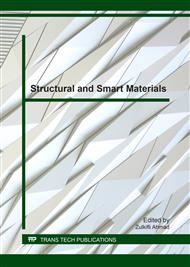p.3
p.8
p.13
p.18
p.24
p.30
p.35
p.40
Effect of Temperature on the Material Properties and the Results of Thermal Stress Analysis
Abstract:
Use of correct values of material properties is important in structural analysis. When incorrect values are used in the analysis, engineers may end up with misleading conclusions. The magnitudes of elastic modulus and strength are usually measured from experiments at room temperature. When these values are used in the thermal stress analysis of structures, the results may not be reliable because the magnitudes of elastic modulus and strength depend on temperature. The temperature distribution of HVAC (Heating, Ventilation and Air Conditioning) system was analyzed. The material properties were measured using MTS810 material test system and MTS 651 environmental chamber at different levels of temperature. They were used in the thermal stress analysis of HVAC system. It was found that the results of thermal stress analysis were significantly different from the results using material properties which were measured from experiments at room temperature.
Info:
Periodical:
Pages:
8-12
Citation:
Online since:
February 2017
Authors:
Price:
Сopyright:
© 2017 Trans Tech Publications Ltd. All Rights Reserved
Share:
Citation:


